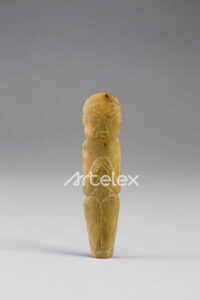This remarkable jade artifact presents the figure of a man with a godlike expression, standing with clasped hands.
The jade itself is yellow, discolored, and translucent, adding to its ancient allure.
It is believed that this ornament may have been worn around the neck of a shaman, possibly sacrificed in a ritual. .
A comparable piece, measuring 18.6 cm in length, was uncovered in the No. 4 tomb at the No. 16 excavation site of Niuheliang. The No. 4 tomb, carved directly into the mountain, is a massive stone chamber measuring 3.9 meters long, 3.1 meters wide, and nearly 5 meters deep. As one of the largest and longest tombs at Niuheliang, it likely belonged to a prominent shaman, possibly the only individual capable of communicating with the gods. Notably, a jade phoenix was found beneath the head of the tomb’s occupant, and a hoop-shaped jade was placed upon the chest.
Given the grand scale of the tomb, the exceptional quality of the jade artifacts discovered within, and the rarity of similar relics, this figure must have held great significance, even in the time of its creation.

